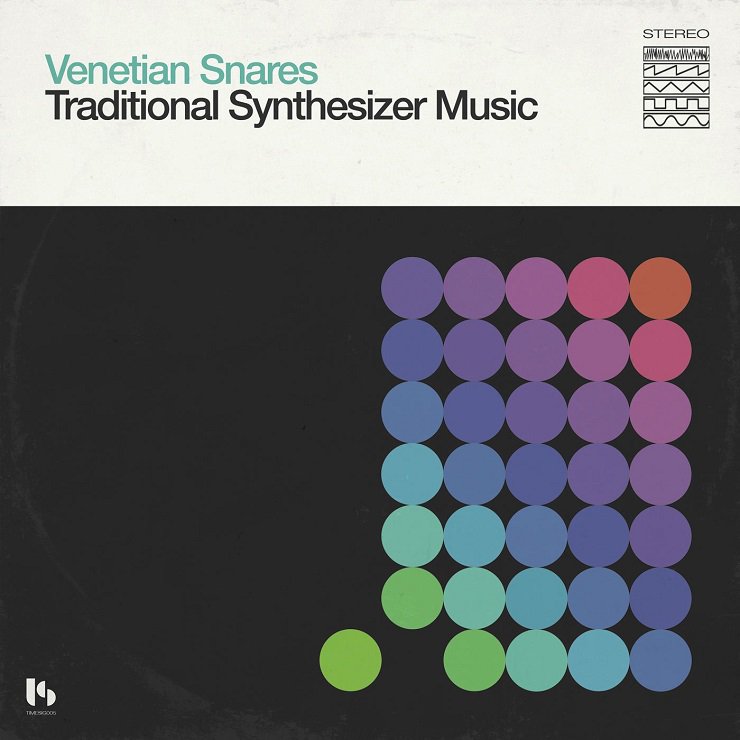When it’s done badly, hauntology goes the way of steampunk – a route-map of nostalgic ephemera taken from Open University broadcasts, the BBC Radiophonic Workshop, Sesame Street, public information films, Ladybird books and such. It’s easy to create something faintly creepy when all the signposts are there. Throw in an old documentary about trains and some slowed-down kids’ voices, and you’re halfway to signing up for the annual convention.
Looking at this album’s artwork, you’d be forgiven for thinking Venetian Snares’ Aaron Funk was all set to do a hatchet job on those who pluck lazily at hauntological tropes in search of an art-form. The design, a play on early electronic records from the 50s and 60s, could almost be a parody within a parody. This has to be a play on the kind of thing Ghost Box Records and others have been doing for years now. Because surely Venetian Snares is above plain-old ‘Keep Calm And Play The Synth’ by this point?
But this is all just wishful thinking, and the austerity bandwagon rolls on. For someone whose other titles include My Love Is A Bulldozer and Winnipeg Is A Frozen Shithole, this kind of rote nostalgia feels oddly out of character. Funk was always about kicking against convention. Each album a new twist on his sound, delivered like a smack to the face.
He first burst onto the electronic music scene as Venetian Snares in the late 90s. A kind of ‘roided-up successor to Richard D James, he came in at a time when so-called ‘intelligent dance music’ was looking increasingly insular. By contrast, his style was anarchic and extroverted, taking Aphex Twin’s signature drill & bass template, and beefing it up via hard dance genres like hardcore and gabba.
2002’s Higgins Ultra Low Track Glue Funk Hits featured an opera singer inciting listeners to "keep jumping, you bastards", while 2003’s Chocolate Wheelchair album saw Funk slicing and dicing everything from Coronation Street to Britney Spears. The brass and string-laden arrangements on Rossz Csillag Alatt Született showed a relatively restrained side to his work, while the Venetian Snares collaboration with Speedranch, Making Orange Things, is still my paint stripper of choice.
And that’s partly why this project feels like an opportunity missed. If there’s a joke here, it’s in the album’s title – Traditional Synthesizer Music. No, this isn’t Venetian Snares’ take on early synth pioneers like Joe Meek or Perrey-Kingsley. Instead it’s the synthesisers that are traditional. TSM is played entirely on modular synths as opposed to a laptop. The music herein is far from traditional in the common sense of the word.
But there is a third, perhaps unintended, interpretation of the title. Despite having put away his laptop to concentrate on a more grass-roots composition method, the music contained on Traditional Synthesizer Music sounds similar in style to what we’ve come to expect from Venetian Snares, traditionally speaking.
To be fair to Funk, the use of modular synths in this setting is formidable. Making music that sounds like this would have been tricky enough on a modern-day laptop. Setting up and programming the racks upon racks of analogue synths and sequencers must have taken a significant amount of time and technical know-how. This aside, it’s understandable that someone who is so highly involved in his craft, so accustomed to making complex rhythms on computers, might fancy taking on a new challenge.
Putting away the laptop and building a nest of wires and flashing analogue equipment sounds like a good way to break free of learnt patterns and to try out something new.
In reality, we find that Venetian Snares is not only a stickler for his usual breakcore-style rhythms but also that he sounds a little hampered by this new approach. Despite his protested attempts to ‘humanise’ his beats using smart algorithmic methods, there’s something cut-off and clinical about the tunes here. Without the breakneck samples and splattercore humour infecting his compositions, it all sounds a bit airless and lacking the same intensity of his other works.
It’s like if a heavy metal band decided to put away their amps and effects and do an unplugged album. Fine, but instead of writing new material that was expressly suited to acoustic instruments, the band instead decided to consolidate every shred solo, every blast beat and cookie monster growl and deaden it through the medium of rosewood and nylon.
Likewise, Traditional Synthesizer Music makes for interesting listening, and no doubt there are synth enthusiasts who would find a lot to get excited about in this album. Non-technical listeners might also find some solace in the fact this sounds remarkably like the kind of late-90s IDM which directly preceded Funk’s entrance on the music scene. Much of it could pass for offcuts from Aphex Twin’s classic Richard D James Album, the detuned saw-waves, the rippling snares. The difference here is that Richard D James Album was the sound of a proudly analogue artist discovering the power of digital processing. It was forward facing, boundary breaking for the time. With the Venetian Snares album, it’s working the other way round; looking back to analogue synthesis but using it to replicate the sound of digital hardware.
So in many ways Traditional Synthesizer Music is true to the title’s word. It’s Venetian Snares going back to the root of his influences by means of a longer-established medium. An admirable idea well executed, but as a listener I’m just not ready for a drill & bass revival and as such this album beggars few repeat plays.


